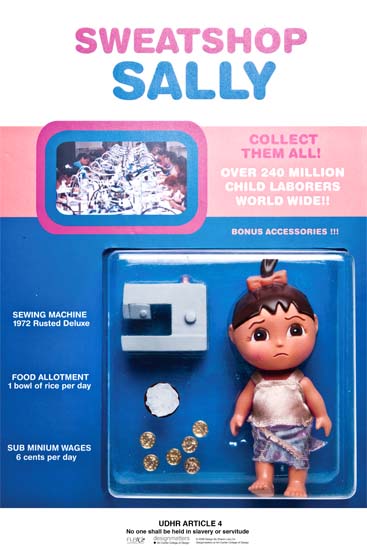With midterms beginning and expensive housing payments due monthly, it’s easy to take basic things like education and shelter for granted. “Images for Human Rights: Student Voices,” a new exhibition at the Skirball Cultural Center, reminds us of their importance.
The free exhibit runs through March 14 and features student-made art, the result of a 14-week class at Pasadena’s Art Center College of Design that focused on creating posters that concerned basic human rights.
The project has its roots in the Universal Declaration of Human Rights, a document written in response to the atrocities of World War II and the first document to outline the fundamental rights of all human beings.
“(The declaration) would be almost a code of conduct so that we wouldn’t have our international community allow (those injustices) to happen anymore,” said Mariana Amatullo, co-founder of Designmatters, the department at Art Center that ran the class.
It was during the 60th anniversary of the declaration, in preparation for a conference held by the United Nations, that “Images for Human Rights” was born.
“We decided that a good contribution to that conference was to have this class look at the declaration and create a series of posters,” Amatullo said.
The original exhibit consisted of 25 posters. Students in the program studied the declaration and selected certain articles and phrases to represent visually.
“What was important to us was to have each artist not only illustrate the different articles but be open to choosing what articles they would relate to and visualize,” Amatullo said.
Artist Ani Gevorgian, for example, was inspired by her experiences as a woman living in the Middle East. Her piece, titled “Equality is Freedom,” revolves around the declaration’s first article, which states, “All human beings are born free and equal in dignity and rights.”
“(The first article) establishes this premise that whether we are poor or rich, black or white, we’re all born equal, and we all have this important right to dignity and freedom.” Amatullo said.
In September 2008, the 25-poster exhibit debuted at UNESCO headquarters in Paris, followed by a short stay at the Pasadena Public Library, where it caught the eye of Skirball staff.
Since October 2009, the exhibit has been in the Skirball’s Ruby Gallery, although the number of posters was reduced to 20 due to space considerations.
“The Skirball is anchored in Jewish and democratic values of justice and equality. We look for exhibitions that have elements of both the human ideals and democratic ideals,” said Erin Clancey, associate curator of the Skirball.
These elements of social justice have roots in the program that birthed the exhibit. Based out of Art Center College of Design, the Designmatters department takes in students of all artistic disciplines and concentrates on creating art with a humanitarian focus.
“Our goal with Designmatters was to create opportunities (for) students and faculty to focus on social and humanitarian issues, and the way we do that is through a lot of partnerships with nonprofits and international agencies,” Amatullo said.
The department is notable for being a nongovernmental organization, providing students and faculty with the means and leeway to work internationally. It also allows students to work with various U.N. agencies to create communications projects.
An important aspect of the exhibit is its focus on clearly communicating the ideals expressed in the Declaration of Human Rights through distinct visuals.
“I felt it was important to define each article in a way that anyone could understand and relate to, especially children,” said Brooke Reidt, another featured student artist, in her personal statement. Her poster, titled “We Need Them All,” is meant to encompass all 30 articles of the declaration.
Although it was drafted more than half a century ago, the issues the declaration addresses remain relevant even to more specific contemporary topics covered by the posters, such as education rights, abandoned mine fields, clean water rights and gay marriage.
“I think that the most important message is that the Universal Declaration of Human Rights … is not something that’s a product of the past, it isn’t history, it’s something that’s needed and is important today,” Clancey said.
